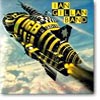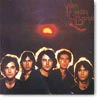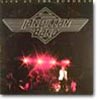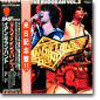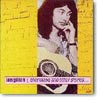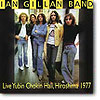Aided by session players Mike Moran (keyboards), Dave Wintour (bass), Bernie Holland (guitar) and Andy Steele (drums), Ian recorded a diverse set of tracks which failed to find favour with Deep Purple's old management team, who suggested he pursue a more rock oriented approach. A spur for Ian to throw himself back into full-time recording and touring was provided by an emotional appearance at Roger Glover's 'Butterfly Ball' live show at the Albert Hall on October 16th 1975, his first stage appearance in over two years. Ian gathered together a recording band consisting of Mike Moran, John Gustafson (who'd been working with Roxy Music - Eddie Jobson was also asked to join but got a better offer from Frank Zappa), and Ray Fenwick (from Fancy), who had all originally played on the Butterfly Ball project, and ex-Elf percussionist Mark Nauseef. The new band was named Shand Grenade for a short time, before the more commercial Ian Gillan Band was settled upon. Roger Glover both produced and played on synthesiser on what became the album 'Child In Time', centred around a reworked version of the Mk2 classic (he also played bass on a promotional TV appearance in early 1976, a mime to 'You Make Me Feel So Good', the only track carried forward from Ian's 1974 sessions). Recorded at Musicland in Dec 75 / Jan 76, and Montreux in Feb 76, 'Child In Time' eventually reached a modest #55 in the UK album charts in July 1976. With the band about to go on the road, Moran bowed out to replaced by ex-Elf & Rainbow keyboard player Mickey Lee Soule.

The
band's debut tour was in France, where Ian was now based for tax
reasons (and why the album was not recorded in Britain). The shows
began in Toulouse on April 14th. With a US support tour with Nazareth
imminent, Lee Soule was replaced by Colin Towns.

The slightly rockier and more accessable 'Scarabus' album arrived later in 1977 and, following a hugely successful Japanese tour in October 1977, two live albums recorded at the Tokyo Budokan were released in 1977-78. However, after a tour of the UK college and club circuit in May 1978, Ian decided to bring the band to a halt. He then began to put together a new one with Colin Towns; inspired by a song called 'Fighting Man' which Towns had written specifically for him. When Ian next played the UK, in August 1978, he was to do so with a band which played hard rock with at least as much aggression and imagination as any other contemporary ac. (photo: back: Mark Nauseef, John Gustafson, Ray Fenwick. front: Colin Towns, Ian Gillan)
.... 1976-78 Ian Gillan Band Discography ....
.... Notable Post 1978 Ian Gillan / Ian Gillan Band CD & Video Releases ....
.... Ian Gillan Band Further Reading ....
|
||||||||||||||||||||||||||||||||||||||||||||||||||||||||||||||||||||||||||||||||||||||||||||
tree index





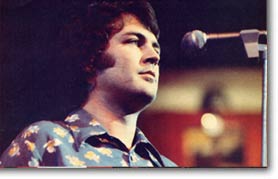 Ian
Gillan remained pretty much out of the public eye for two years
following his departure from Deep Purple. In that time he involved
himseff in a number of business interests, including motorcycle
engines, a country hotel / restaurant (with a guitar shaped swimming
pool), and ownership of the Kingsway Recorders studio, where from
April 1974 he began to work on his first post-Deep Purple solo tracks.
Ian
Gillan remained pretty much out of the public eye for two years
following his departure from Deep Purple. In that time he involved
himseff in a number of business interests, including motorcycle
engines, a country hotel / restaurant (with a guitar shaped swimming
pool), and ownership of the Kingsway Recorders studio, where from
April 1974 he began to work on his first post-Deep Purple solo tracks.



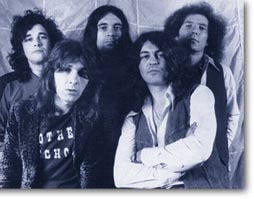 The
band's music quickly evolved into a form of complex jazz rock, driven
by Fenwick's guitar style and the percussion work. Their next album
was 'Clear Air Turbulence', recorded in 1976, but delayed until
April 1977 following a thorough remix. It failed to chart in the
UK. Although containing some excellent music, it was dropped into
a UK music scene caught up in punk and new wave, and IGB's music
simply did not fit. The accompanying tour also caused some confusion
among Purple fans, who were unsure how to take jazzy versions of
'Smoke On The Water' and 'Woman From Tokyo'. It was music aimed
more at musicians than audiences.
The
band's music quickly evolved into a form of complex jazz rock, driven
by Fenwick's guitar style and the percussion work. Their next album
was 'Clear Air Turbulence', recorded in 1976, but delayed until
April 1977 following a thorough remix. It failed to chart in the
UK. Although containing some excellent music, it was dropped into
a UK music scene caught up in punk and new wave, and IGB's music
simply did not fit. The accompanying tour also caused some confusion
among Purple fans, who were unsure how to take jazzy versions of
'Smoke On The Water' and 'Woman From Tokyo'. It was music aimed
more at musicians than audiences. 




